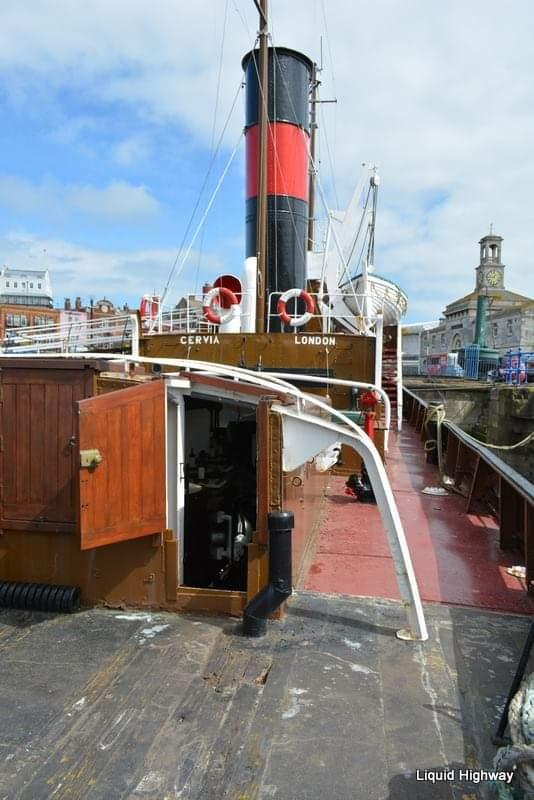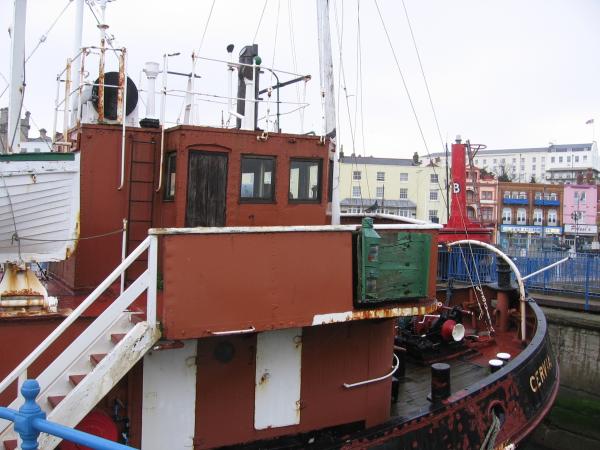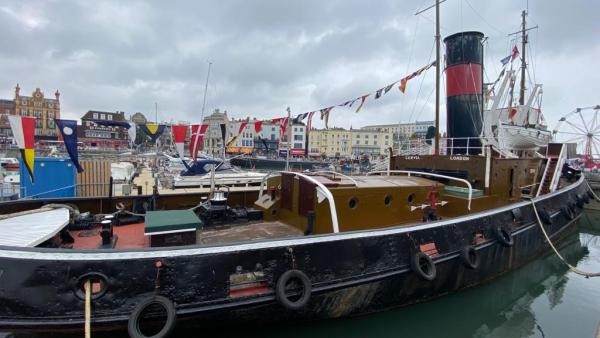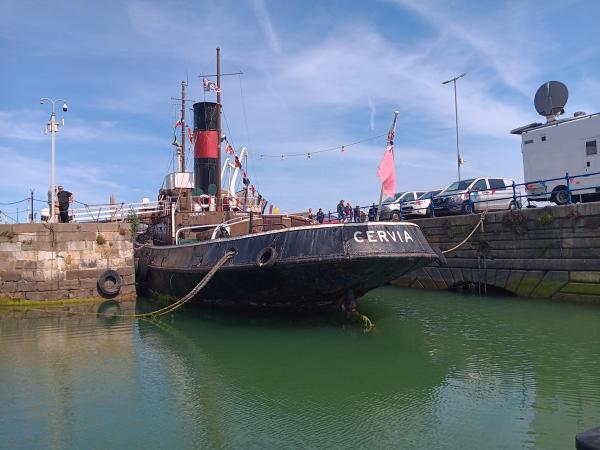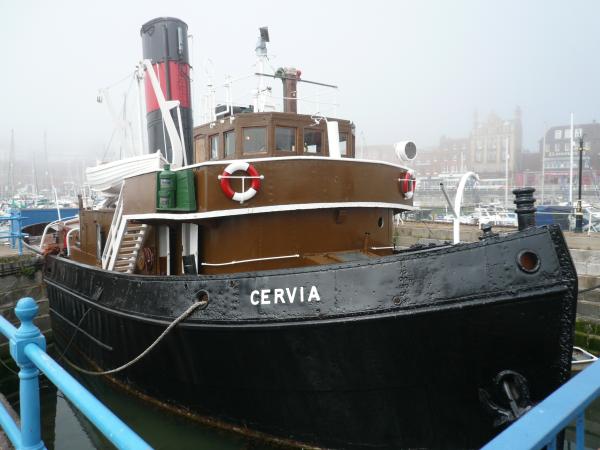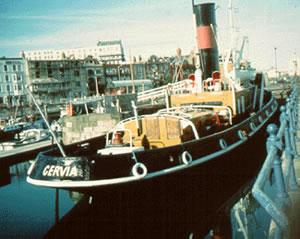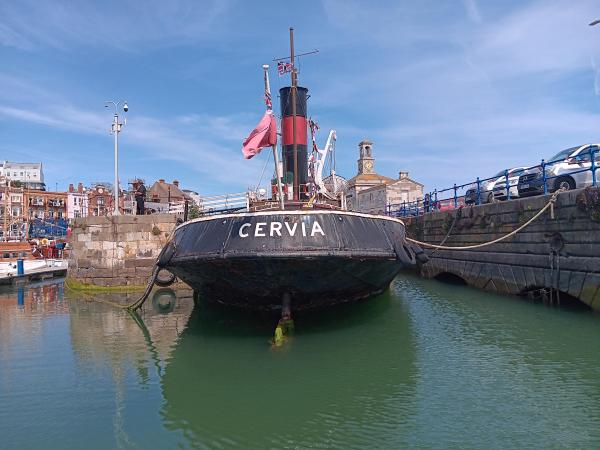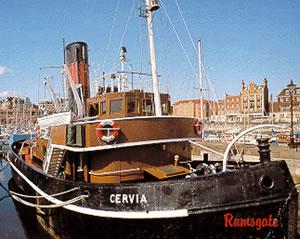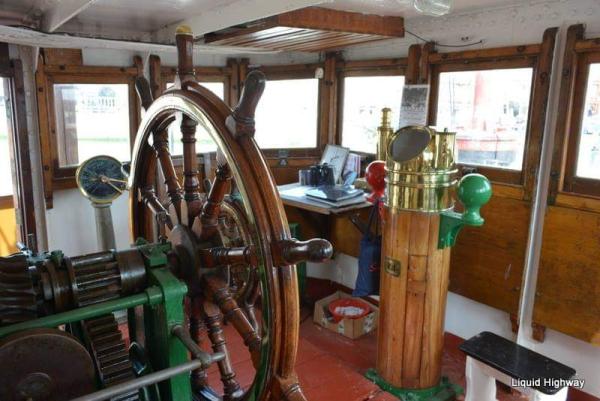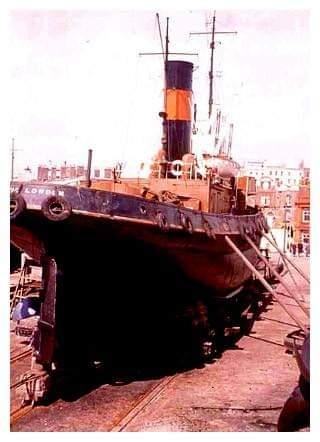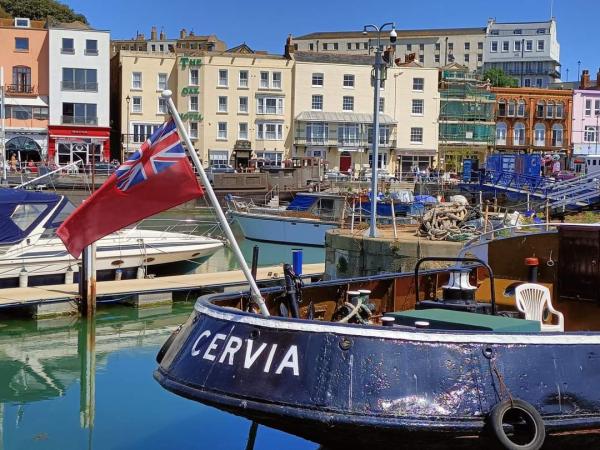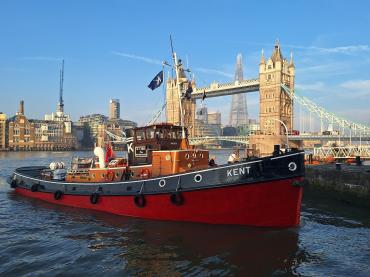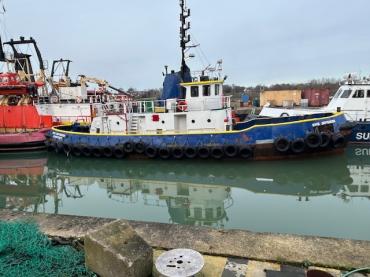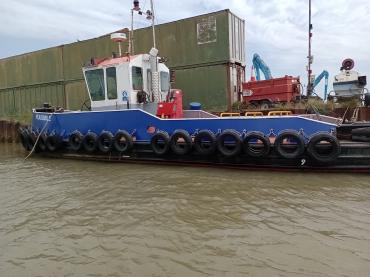

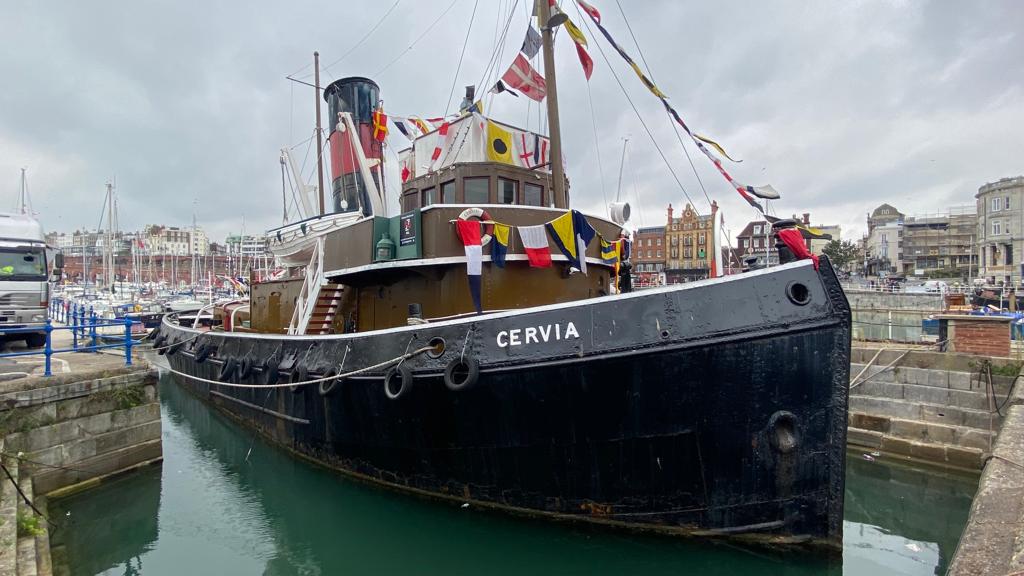
Previous names
- 1945 - 1947 Empire Raymond
Details
Construction
Dimensions
History
During the Second World War, approximately 144 intermediate-sized tugs were build between 1941-1946 for the Ministry of War Transport. They were given 'Empire' names, as was the practice for war-built merchant ships in Britain. EMPIRE RAYMOND was completed on 30 April 1946 by Alexander Hall & Co. Ltd, Aberdeen (who also built her engines).
CERVIA's type was based on the design of the FOREMOST of 1928. She was handed over to Townsend Bros Ferries for onward delivery. In December 1946, EMPIRE RAYMOND was sold to William Watkins Ltd, a London tug company, and renamed CERVIA.
For two years, she was employed on towing duties between ports on both sides of the English Channel before moving to be based at Gravesend. On 1 February 1950, an amalgamation of towing companies put her ownership under Ship Towage (London) Ltd but she retained her Watkins colours. On 26 October 1954, she was assisting with the undocking of the P. & O. liner ARCADIA, stern first, when, to avoid collison with another vessel, ARCADIA put her engines ahead and pulled the CERVIA sideways so that the tug capsized and sank, with the loss of her master and four crew. She was raised two days later and taken to Ramsgate (where Watkins had a repair yard) for a refit.
On 27 January 1969, further rationalisation of companies made her part of London Tugs Ltd. In 1971, CERVIA was laid up at Sheerness and was sold in the following year, ostensibly for preservation under the aegis of the Medway Maritime Trust. However, after a refit, she returned to towing service in 1974, working in the North Sea and elsewhere on coastal towage. A new company, International Towing Ltd, was formed and owned several tugs based at Ramsgate. She remained in service with that company until 1983, her final duties being as a port tug for the new cross-channel ferry service at Ramsgate, assisting in adverse weather conditions.
She was laid up at Ramsgate and, in July 1985, was loaned to Ramsgate Maritime Museum, run by the East Kent Maritime Trust. She was refitted and repainted in the Watkins colours, berthed in Smeaton's historic dry dock, and opened to the public. In the mid-1990s, her engine was restored to full working order. The Steam Museum Trust later took over her care and upkeep from 2009 with several years of intensive cosmetic restoration works above the water line inside and out, and the boat reopened to public. In December 2018 Cervia partially sunk after a small area of internal hull rust corrosion caused a leak. A concrete patch was fitted and the boat was refloated.
In early 2024, her volunteer crew, supported by the Steam Tug Cervia Preservation Trust, were in the process of conserving her fabric with a view to reopening her to the public as a 'Museum of Tugs', based in Ramsgate.
Significance
- What is the vessel’s ability to demonstrate history in her physical fabric?
Evidence for designs, functions, techniques, processes, styles, customs and habits or uses and associations in relation to events and people. How early, intact or rare these features are may impact on significance.
Cervia is a riveted ocean-going steel tug, with an oil-fired 900HP triple-expansion steam engine. She was built during wartime by Alexander Hall & Co. of Aberdeen to the tried-and-tested 1923 Foremost class design for simplicity of construction and to avoid design development delays. The design included an armoured bridge complete with steel shelter, anti-mine degaussing equipment, and a gun emplacement. The bridge still retains this feature today and the vessel is equipped with a degaussing generator.
The vessel is largely unchanged from the design and build, retaining her original features. The hull, propulsion system, and superstructure are as built, and the vessel has kept the original wheel, binnacle, and compass, as well as the original navigation lanterns and lifeboat. The original speaking tube from the bridge to the captain’s quarters is still in place and operational. The only adaptations are the addition of antennae to support a more modern radio and navigational aids, but these do not detract from the overall appearance.
Conservation work has largely been confined to repainting the superstructure, and Cervia retains the colour scheme from her early service as a Watkins tug. Some concrete patches were applied to the hull in 2018 as a temporary measure to keep her watertight.
- What are the vessel’s associational links for which there is no physical evidence?
Associations with people or places. Off-ship research.
Cervia was ordered by the Ministry of War Transport to replenish war losses in readiness for the invasion of Europe but was not completed until April 1946 thus avoiding direct involvement in wartime service. However, she did take part in post-war operations in Europe and reportedly in Iceland. She was built in Scotland but her strongest association is to the River Thames, where she was based for the majority of her working life after being sold to William Watkins Ltd, one of the foremost ship towage companies in Great Britain. She is believed to be one of only three Empire class vessels surviving from the period, and the only one in the UK.
Between 1947 and 1971, Cervia was based at Gravesend for ship towage operations on the Thames and further afield. She has a significant maritime link to Gravesend and its local inhabitants, many of whom acted as crew or are descended from families who worked on tugs. In 1954, Cervia was involved in a tragic accident with the liner Arcadia which is documented on film and saw the vessel capsize with the loss of five crew members, including her captain.
When Cervia was sold in 1971, she was reported as being the last steam tug still in operation on the Thames. With her largely unchanged superstructure and interior, including original bunks and cabin furniture, she provides a valuable insight into the working conditions and way of life of tugmen during the mid-20th century.
From 1973 until 1983, the vessel formed part of International Towage Ltd, and was primarily based at Ramsgate, engaged in deep-sea salvage and servicing the North Sea oil rigs. During this period, the vessel assisted a number of vessels stranded on the Goodwin Sands. When Cervia finally retired, she was the last steam tug still in operational use in the UK.
Cervia has been in preservation as a static floating museum for forty years, welcoming many local residents and tourists onboard. In 1986, she was visited by Queen Elizabeth the Queen Mother. She appeared as a setting in scenes from the 1976 BBC film “Rogue Male” starring Peter O’Toole and featured in an episode of the popular TV series “Ripping Yarns” first televised in 1977. A number of documents survive from her working life, including the original shipyard general arrangement drawings, her certificate of registration and a photographic archive.
Cervia was recorded on the National Register of Historic Vessels in 1996 and is a member of the National Historic Fleet.
- How does the vessel’s shape or form combine and contribute to her function?
Overall aesthetic impact of the vessel, her lines, material she was built from and her setting. Does she remain in her working environment?
Cervia was built as an ocean-going steam tug, with the invasion of Europe in mind. Accordingly, she was constructed with a powerful engine and a heavy gauge riveted steel hull and superstructure to a scale designed to cope with the rigours of deep-sea operations. Her design also lent itself well to ship towage on the River Thames where the vessel was based. She required no modifications or adaptions to undertake her role in salvage operations and North Sea oil servicing in its later working life and remains largely unchanged from when she left the shipyard.
Aesthetically, the vessel is highly representative of her time, being based on the 1923 Foremost class which was the pattern for a number of tugs in the 1920s, 30s, and 40s, and which survived into the 1960s and 70s. The vessel is built for practicality rather than for aesthetic appearance. Nevertheless, the sweeping lines of the vessel are instantly familiar, pleasing to the eye, and characteristic of UK maritime heritage.
Cervia is currently moored in Smeaton's Dry Dock in Ramsgate and is being conserved by volunteers with the aim of re-opening her to the public as a static museum initially, although a return to operational use may be considered if found to be a practical proposition.
Sources:
Aberdeen Ships / Alexander Hall & Sons Ltd
“6 Drown in Tug Disaster” – British Pathé
Mitchell, William Harry & Sawyer, Leonard Arthur (1990). The Empire Ships (2nd ed.). London, New York, Hamburg, Hong Kong: Lloyd's of London Press Ltd. ISBN 1-85044-275-4.
Rogue Male (BBC, 1976) - (https://www.youtube.com/watch?v=yMtGmGa8KZ0)
The Curse of the Claw, Ripping Yarns (1977) - (https://www.youtube.com/watch?v=NEAevDIAwS4&t=1432s).
Author: The Steam Tug Cervia Preservation Trust, updated April 2024
Key dates
- 1945-46 Built Aberdeen as a steam tug for the Ministry of War Transport and named EMPIRE RAYMOND
- 1946 Handed over to Townsend Ferries for onward delivery
- 1946 Sold to William Watkins, a London Tug Co and re-named CERVIA
- 1947 Assisted in rescue of the Cunard liner, QUEEN ELIZABETH that had gone aground
- 1946-1949 Employed on towing duties between ports on both sides of the English Channel before moving to Gravesend
- 1950 Transferred to Ship Towage (London)
- 1954 Capsized and sank whilst towing the P&O liner ARCADIA from Tilbury Dock to the landing stage. The skipper and four crew were drowned. Raised two days later and taken to Ramsgate for a refit
- 1969 Further rationalisation made her part of the London Tug Co, an amalgamation of Ship Towage and Alexander and Co Ltd
- 1971 Sold for preservation to the Medway Maritime Museum
- 1973 Returned to towing working in the North Sea and elsewhere on coastal towage for a new company, International Towing Ltd
- 1973-83 Remained in service with that company, her final duties being as a port tug for the new cross-channel ferry service at Ramsgate, assisting in adverse weather conditions
- 1985 Laid up in Ramsgate and loaned to Ramsgate Maritime Museum, run by the East Kent Maritime Trust. She was refitted and repainted in the Watkins colours, berthed in Smeaton's historic dry dock and opened to the public.
- Mid-1990s Engine was restored to full working order
- 2011 Still in Smeatons dry dock, managed by her owner
Grants
-
September 2013
A Sustainability Grant of £1000 for remedial work was made from the Strategic Development Fund of National Historic Ships UK
Sources
Brouwer, Norman J, International Register of Historic Ships, Anthony Nelson, pp142, Edition 2, 1993
Steamboat Register: An illustrated Register of surviving steam vessels in the British Isles, Steam Boat Association of Great Britain, May Edition 6, 1994
Brouwer, Norman J, Steam Tug Cervia - A Brief History, East Kent Maritime Trust
Own this vessel?
If you are the owner of this vessel and would like to provide more details or updated information, please contact info@nationalhistoricships.org.uk

